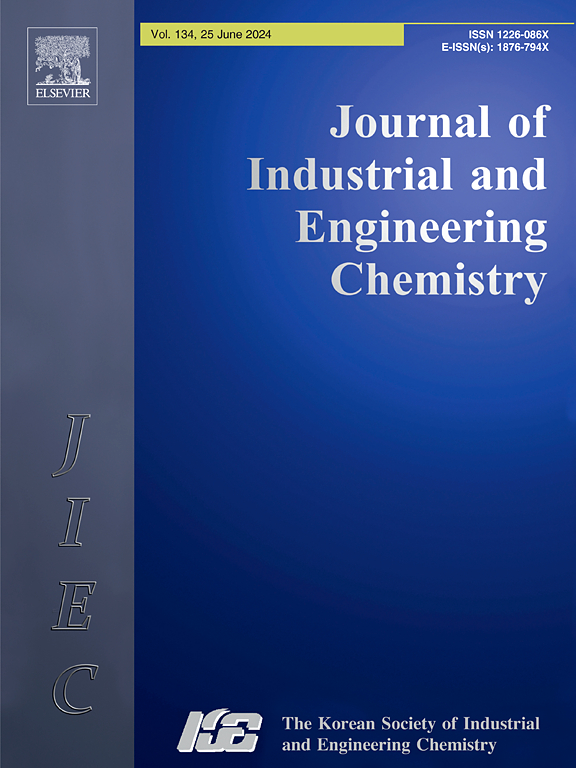Synthesis of novel mesoporous polyvinylamine functionalized with 2-Mercapto-N-methylbenzamide for mercury ions removal from industrial wastewater effluent
IF 5.9
3区 工程技术
Q1 CHEMISTRY, MULTIDISCIPLINARY
Journal of Industrial and Engineering Chemistry
Pub Date : 2025-02-22
DOI:10.1016/j.jiec.2025.02.043
引用次数: 0
Abstract
This research introduces a groundbreaking, high-efficiency adsorbent for the remediation of mercury ion contamination in industrial wastewater effluents. A novel chelating polymer, 2-Mercapto-N-methylbenzamide-functionalized polyvinyl amine (PVAm-MMB), was synthesized via a facile acid-catalyzed condensation reaction, strategically incorporating amine, imine, and thiol functionalities to facilitate robust mercury sequestration. Rigorous structural characterization was undertaken utilizing a comprehensive suite of analytical techniques, including elemental CHNS analysis, FTIR spectroscopy, NMR spectroscopy, SEM-EDX microscopy, BET surface area analysis, GC–MS spectrometry, TGA analysis, and XPS spectroscopy, definitively confirming the desired structural attributes of the synthesized material. Subsequent adsorption studies demonstrated the exceptional performance of the mesoporous PVAm-MMB, exhibiting a significant specific surface area (SBET) of approximately 73.7 m2/g, a total pore volume (Vm) of approximately 0.31 cm3/g, and an average pore width of approximately 21.4 nm. Remarkably, the PVAm-MMB achieved a maximum adsorption capacity of approximately 62.9 mg/g under optimized conditions (pH 4.5, 25 °C, 20 min contact time, 1 g/L adsorbent concentration, and 200 mg/L Hg2+ initial concentration). Langmuir isotherm modeling provided a superior fit to the experimental adsorption data compared to the Freundlich model, indicating a monolayer adsorption mechanism. Furthermore, pseudo-first-order kinetics accurately described the adsorption process; the calculated value for qe,1 was 49.88 mg/g, which is quite aligned with the actual value of 48.6 mg/g. Thermodynamic analyses revealed the adsorption process to be spontaneous, exothermic (ΔH = −88.07 kJ/mol), and thermodynamically favored at lower temperatures. A plausible adsorption mechanism is proposed, and importantly, the adsorbent demonstrated excellent reusability. The efficacy of the PVAm-MMB was validated through the successful treatment of real-industrial mining wastewater effluent, achieving significant removal of mercury, thereby showcasing its substantial potential for practical environmental remediation applications.

2-巯基- n -甲基苄胺功能化新型介孔聚乙烯胺的合成及其对工业废水中汞离子的去除作用
本研究介绍了一种突破性的高效吸附剂,用于工业废水中汞离子污染的修复。通过酸催化缩合反应合成了一种新型螯合聚合物- 2-巯基- n -甲基苯酰胺功能化聚乙烯胺(PVAm-MMB),该聚合物战略性地结合了胺、亚胺和硫醇的官能团,以促进强劲的汞螯合。采用综合的分析技术进行了严格的结构表征,包括元素CHNS分析,FTIR光谱,NMR光谱,SEM-EDX显微镜,BET表面积分析,GC-MS光谱,TGA分析和XPS光谱,最终确定了合成材料所需的结构属性。随后的吸附研究证明了介孔pmam - mmb的优异性能,表现出显著的比表面积(SBET)约为73.7 m2/g,总孔容(Vm)约为0.31 cm3/g,平均孔径约为21.4 nm。在最佳条件(pH 4.5、25℃、接触时间20 min、吸附剂浓度1 g/L、Hg2+初始浓度200 mg/L)下,pmam - mmb的最大吸附量约为62.9 mg/g。与Freundlich模型相比,Langmuir等温线模型对实验吸附数据有更好的拟合,表明其为单层吸附机制。准一级动力学准确地描述了吸附过程;qe,1的计算值为49.88 mg/g,与实际值48.6 mg/g相当一致。热力学分析表明,吸附过程是自发的,放热的(ΔH = - 88.07 kJ/mol),在较低温度下热力学有利。提出了一种合理的吸附机理,重要的是,吸附剂具有良好的可重复使用性。PVAm-MMB的有效性通过成功处理实际工业采矿废水废水得到验证,实现了大量的汞去除,从而显示了其在实际环境修复应用中的巨大潜力。
本文章由计算机程序翻译,如有差异,请以英文原文为准。
求助全文
约1分钟内获得全文
求助全文
来源期刊
CiteScore
10.40
自引率
6.60%
发文量
639
审稿时长
29 days
期刊介绍:
Journal of Industrial and Engineering Chemistry is published monthly in English by the Korean Society of Industrial and Engineering Chemistry. JIEC brings together multidisciplinary interests in one journal and is to disseminate information on all aspects of research and development in industrial and engineering chemistry. Contributions in the form of research articles, short communications, notes and reviews are considered for publication. The editors welcome original contributions that have not been and are not to be published elsewhere. Instruction to authors and a manuscript submissions form are printed at the end of each issue. Bulk reprints of individual articles can be ordered. This publication is partially supported by Korea Research Foundation and the Korean Federation of Science and Technology Societies.

 求助内容:
求助内容: 应助结果提醒方式:
应助结果提醒方式:


